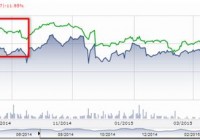Nuveen’s Real Asset Income And Growth Fund: Possible 25% Total Return In 1 Year
Summary In January 2014, Nuveen’s Real Asset Income and Growth Fund had a distribution rate of 9.61%, monthly distributions, and was trading at a discount to market price, and was discounted further than the 3-year discount average. Those three fund characteristics have come back, which is what prompted me to write this article. Bottom line, JRI has approximately 25% of total return for investors, assuming the market realizes the market opportunity, total distributions, and narrowing discount to the fund’s net asset value. Most investors have realized by now that the situations in Greece and China have created overhangs on broader stock markets, including the U.S. markets. Even though most investors are looking at impacted portfolio performance, there are opportunities to rotate their assets out of equity stocks of companies and into securities that invest in equities and bonds of securities of global real asset-related companies. Nuveen’s Real Asset Income and Growth (NYSE: JRI ) fund does exactly that, invests in global real asset-related companies. Given that real assets have the tendency of reacting in a less volatile manner to market overreactions, the assumption is that they make good investments during times like these with China, Greece, Puerto Rico, and potentially Iran flooding the market with headline-grabbing issues. This article will be focused on JRI rather than parroting the media on the geopolitical events that have recently stormed the market. About a year and a half ago, I put out my first analysis of JRI ( found here ), and I wanted to reiterate some of my findings at the time. In January 2014, JRI had a distribution rate of 9.61%, monthly distributions, and was trading at a discount to market price, and was discounted further than the 3-year discount average. Those three fund characteristics have come back, which is what prompted me to write this article. Below I will layout my investment case for investors seeking relief from the market’s current volatility, and highlight the opportunity for JRI’s large dividend distributions. JRI’s Discount is a Buying Opportunity – An opportunity that has not come up in nine months… (click to enlarge) Source: Morningstar.com JRI Could Yield over 16% in the next 12 months – JRI’s dividend distributions are primarily composed of fund income from real asset investments, and the short-term and long-term capital gains are a bonus that most investors overlook when considering the fund. JRI distributes 13 cents per month, and when annualizing the dividend value and dividing by the trading price, you get approximately 9% of yield. Based on the chart below, JRI has managed to distribute gains on investments in excess of the 9% yield, meaning an investor could end up collecting approximately 16% of total dividend distributions assuming they hold for 12 months and through December or January of each year when the capital gain dividend is paid out (the 16% distribution is assuming no dividend reinvestment takes place, meaning the return could be even higher if dividend distributions are reinvested as they come in). The 16% yield figure is also assuming that 2015 distributions are in the same range as 2014 distributions of $1.614 of fund income, $1.074 of short-term capital gains, and $0.101 of long-term capital gains. The monthly distributions of fund income are expected to come in as planned; the capital gains distributions are the bonus. Distribution Composition is Very Attractive – The Capital Gains are a bonus to fund holders, in addition to monthly distributions… Source: Morningstar.com JRI is Focused on Real Estate and Utilities-backed hard assets – This is the source of the stable monthly income and explains the capital gains on positions that turned out to be favorable for total returns. (click to enlarge) Source: Morningstar.com Bottom line, JRI has approximately 25% of total return for investors assuming the market realizes the market opportunity (driving the trading price up to normal trading levels), total distributions (fund income + capital gains), and narrowing discount to the fund’s net asset value (gives new investors a buffer for downside). The capital gain dividend is a data point many investors overlook when browsing through closed-end fund investments, and this opportunity gives investors access to large distributions and capital stability. Disclosure: I am/we are long JRI. (More…) I wrote this article myself, and it expresses my own opinions. I am not receiving compensation for it (other than from Seeking Alpha). I have no business relationship with any company whose stock is mentioned in this article.
